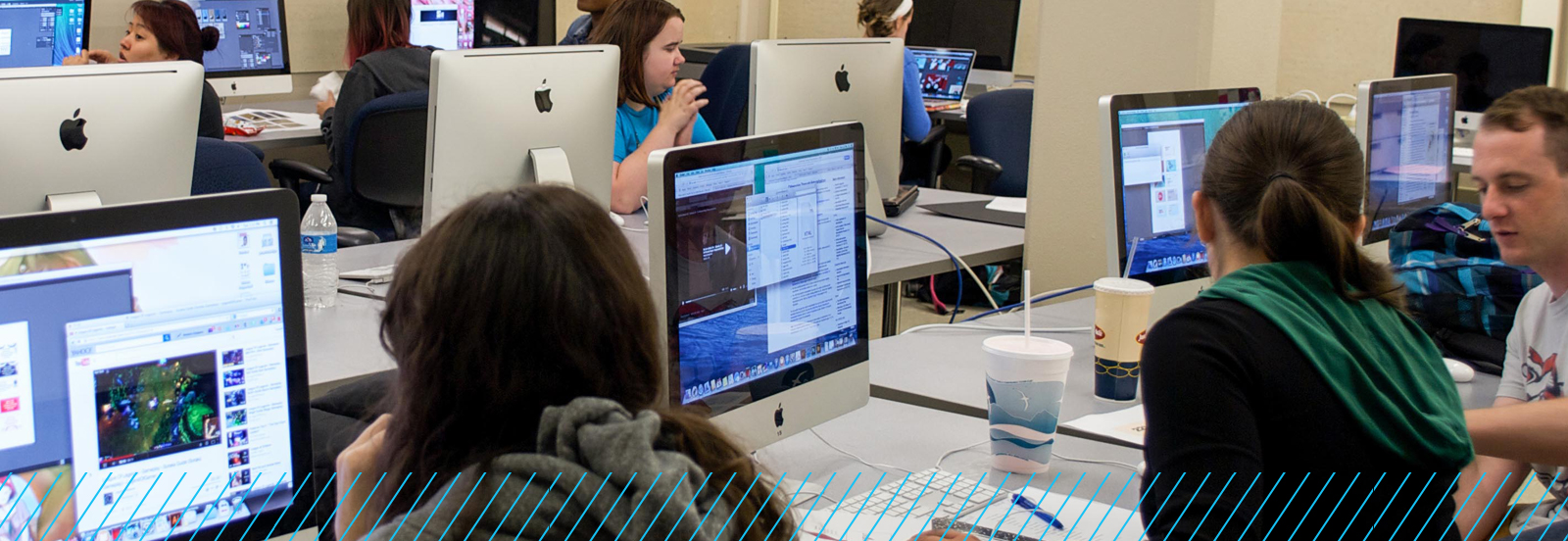Department of Art and Design
Art - Graphic Design, B.F.A.

Graphic design is about using typography, imagery, color, and other design elements to create visually appealing and effective communication pieces. It requires a deep understanding of design principles, as well as an ability to effectively communicate with clients and target audiences.
Overview
In the graphic design concentration, students focus on developing a solid foundation in the principles and techniques of graphic design. They learn about the elements of design, such as line, shape, color, texture, and typography, and how to use them effectively to create visually appealing and meaningful communications. Students gain proficiency in industry-standard design software and learn how to apply these tools to their design projects.
The curriculum includes courses in art and design history, which help students understand the evolution of art and design and the cultural and social contexts that influence them. They also study composition, layout, and visual communication, learning how to arrange elements on a page or screen to create balanced and engaging designs.
Students engage in hands-on projects and assignments that allow them to apply their skills and knowledge. They work on designing logos, posters, brochures, websites, and other visual materials. Through these projects, they learn to identify and solve design problems, think critically about design decisions, and effectively communicate messages through visual means.
Collaboration and critique are integral parts of a graphic design program. Students participate in group projects, workshops, and design critiques, where they receive feedback from peers and instructors. This helps them refine their designs, learn from different perspectives, and develop a critical eye for design.
Students have opportunities for internships and engage in real-world projects to gain practical experience and build their portfolio, which is essential for future job prospects.
The program culminates in a capstone project and final exhibition that showcases students' artistic growth, technical proficiency, and conceptual development. This exhibition serves as a platform to launch their professional careers as practicing designers, pursue further studies, or explore opportunities within the field.
Curriculum and Concentration Requirements
Please review the official academic catalog for comprehensive information on requirements.
Careers
Concentrating in graphic design can lead to a variety of careers in the arts and creative industries. Possible career paths for students concentrating in graphic design:
- Graphic Designer: Graphic designers use their artistic skills and knowledge of design principles to create visual communication materials, such as logos, advertisements, packaging, and websites. They use digital design software to create effective and engaging designs.
- Art Director: Art directors work in advertising, publishing, and other media industries to oversee the visual elements of a project, including graphics, images, and layout. They use their knowledge of design principles and project management to ensure that the final product meets the client's needs and goals.
- User Experience (UX) Designer: UX designers work in technology and software companies to create digital products and experiences that are engaging, easy to use, and effective. They use their knowledge of design principles, user research, and psychology to create intuitive and user-friendly interfaces.
- Web Designer: Web designers create engaging and effective websites using their knowledge of design principles, web development technologies, and user experience principles. They may specialize in a particular type of web design, such as e-commerce, responsive design, or interactive design.
- Brand Identity Designer: Brand identity designers create visual identities for companies and organizations, including logos, color schemes, and other visual elements that define the brand's personality and message. They use their knowledge of design principles and branding strategies to create effective and engaging visual identities.
- Packaging Designer: Packaging designers create visual designs for product packaging, including labels, boxes, and bags. They use their knowledge of design principles and branding strategies to create effective and engaging packaging designs.
- Creative Director: Creative directors work in advertising agencies, media companies, and other creative industries to oversee the creative process and ensure that projects meet the client's needs and goals. They use their knowledge of design principles, project management, and communication to lead teams of designers and other creative professionals.
Depending on students’ interests and skills, their knowledge of design principles and digital design software can be applied in many different ways.
Facilities
MN Room 313, 140 SQ FT
- 1 Ricoh Aficio MP 2550B copy machine
- 1 iDraw 2.0 H-Structure A0 pen plotter
MN Room 318, 1056 SQ FT
- 21 iMac computers
- 2 Nippon Electric Company 80-inch LCD screens
- 1 Epson Expression 10000 XL scanner
- 2 Art Alternatives cutting mats
MN Room 318A, 203 SQ FT
- 1 Xerox Phaser 7500 printer
- 1 Hewlett-Packard Laserjet 700 B/W printer
- 1 Canon imagePROGRAF iPF6400SE printer
- 1 Makerbot MethodX 3D printer
- 3 Makerbot Method 3D printers
- 6 Makerbot Replicator+ 3D printers
- 1 Formlabs Form 3+ 3D printer
- 2 Formlabs Form Wash accessories
- 1 Formlabs Form Cure accessory
MN Room 408A, 643 SQ FT
- 21 iMac computers
- 2 Nippon Electric Company 80-inch LCD screens
- 1 Epson Expression 1000 XL scanner
- 1 Xerox Phaser 7500 printer
- 1 Hewlett-Packard Laserjet 700 B/W printer
